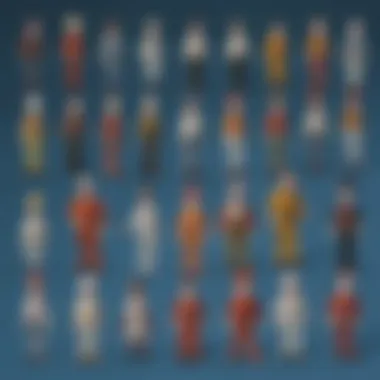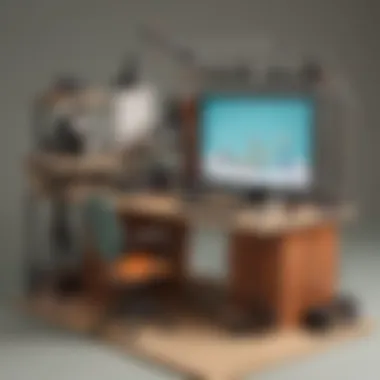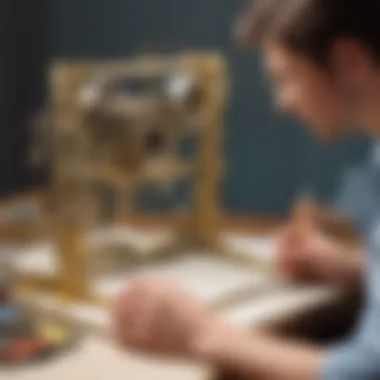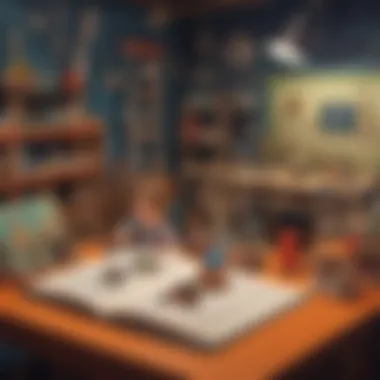Unveiling the Art and Science of Stop Motion Video


Intro
Stop motion video is a captivating technique that intrigues both young and old. By capturing a series of images of stationary objects, animators can create the illusion of movement. This process not only highlights creativity but also involves scientific principles related to physics and light.
This article presents a deep examination of stop motion video, from its rich historical background to modern advancements. It aims to provide a thorough understanding, combining both the artistry and the science behind this unique form of animation. Each section will delve into critical facets, serving as a resource for aspiring animators and educators.
Science Fun Facts
Understanding the intersection of art and science can be fascinating. Here are some engaging facts related to stop motion video:
- The First Experiment: The earliest known use of stop motion can be traced back to 1897. A filmmaker named Albert E. Smith created a short film where a man’s head was replaced by a pumpkin, illustrating movement through sequence.
- Persistence of Vision: This principle explains why we perceive motion in the still images of a stop motion film. The human brain combines rapidly shown images into a fluid motion, making stop motion a perfect example of this phenomenon.
- Variety of Materials: Animators have used various objects for stop motion, including clay, toys, and everyday items. Each material requires specific techniques which influence the final aesthetic of the film.
- Frame Rate Importance: Most stop motion films use a frame rate of 12 to 24 frames per second. Adjusting the number of frames can drastically change the speed and fluidity of the animation.
"Stop motion captures magic moments that might otherwise go unnoticed in everyday life."
- High-Tech Enhancements: Modern stop motion frequently involves digital tools. Software can assist in editing and providing a smoother overall feel to animations.
Discover the Wonders of Science
In addition to the visual impact, various scientific concepts emerge when creating stop motion videos. Here are some aspects to explore:
- Physics of Movement: Understanding motion principles helps animators depict believable movements. Concepts like gravity and weight distribution play crucial roles in creating realistic animations.
- Light and Shadow: Lighting in stop motion films is crucial. It affects the mood and depth of scenes. Proper light management can create dramatic effects or realistic textures.
- Technology in Education: Educators can use stop motion video to teach complex ideas in a simple visual format. Through animations, difficult concepts become easier to grasp.
Educational Videos and Animations
The use of animations in education can engage students in a way that traditional methods may not. For example, short animations explaining science phenomena can enhance understanding and retention of information.
Real-Life Applications of Science
In the realm of practical applications, stop motion can be used in various fields. Whether for educational purposes or artistic expression, many professionals utilize stop motion to convey messages that resonate with audiences.
Science Quiz Time
To enhance learning, here are some interactive quiz questions:
- What is the minimum number of frames required for a smooth stop motion video?
- Which principle explains why we see motion in stop motion videos?
- a) 10
- b) 12
- c) 24
- a) Reflection
- b) Persistence of Vision
- c) Friction
Learning Through Gamification
By incorporating quizzes and interactive elements, students can engage with the material actively. This engagement makes learning both fun and effective.
Science Experiment Showcase
Creating simple experiments can provide a hands-on experience. Here’s a straightforward guide for making a basic stop motion project:
Fun and Engaging Experiment
- Project Name: Animate a Toy
Step-by-Step Instructions
- Choose a toy or an object.
- Set up a camera on a tripod.
- Take a photo of the object in one position.
- Move the object slightly and take another photo.
- Repeat the process, adjusting the position incrementally.
- Compile the pictures into a video.
Materials List


- A toy or object
- A camera or smartphone
- A tripod (optional but helpful)
- Software for compiling images (e.g., iMovie, Windows Movie Maker)
Safety Tips and Precautions
- Ensure the work area is safe and free from potential hazards.
- When using a camera, ensure it is stable to avoid accidents.
Through these sections, readers can appreciate the blend of art and science within stop motion video, inspiring their creativity while fostering understanding of fundamental principles.
Understanding Stop Motion Video
Understanding stop motion video is crucial for grasping the dynamics of this captivating animation technique. Stop motion fuses art and technology, creating a unique form of storytelling that can engage both creators and viewers alike. With its capacity to breathe life into inanimate objects, it fosters creativity and innovation. This section will outline its fundamental definition and the mechanical processes that underpin this artistic craft.
Definition of Stop Motion
Stop motion animation is a cinematic technique where objects are physically manipulated and photographed frame by frame. Each frame captures a slight change in position, and when played in succession, these frames create the illusion of movement. Essentially, stop motion relies on a sequence of still images that, when sequenced, performs like a video. This technique allows animators to control every aspect of their scenes precisely. Through this definition, we can see how the art of stop motion transforms static objects into dynamic narratives, making it a powerful tool for storytellers of all ages.
Mechanics Behind Stop Motion Animation
The mechanics of stop motion animation are rooted in a few key principles of photography and motion. Firstly, the use of a digital or film camera is essential. The camera must be stable and precisely position for each shot — any movement can disrupt the flow of animation, leading to awkward transitions. A tripod comes in handy here, ensuring the camera remains immobile.
Another crucial element is lighting. Consistent lighting is necessary to maintain visual continuity between frames. Variations in light can confuse viewers and detract from the flow of the narrative.
Additionally, animators often utilize software to compile the captured images. This software allows for editing, frame rate adjustment, and sound integration, enriching the final product. The synergy between these mechanical components is what makes stop motion an intricate science, alongside its artistic flair.
"Stop motion is not just about moving objects; it’s about telling a story, frame by frame."
Historical Development
The historical development of stop motion animation is crucial for understanding its significance in the realm of visual art and storytelling. This technique does not simply entertain; it also provides insight into the evolution of cinematic expression and technological advancements. The journey of stop motion animation reflects the creativity and ingenuity of various artists over the years, shedding light on how a simple concept gradually transformed into an acclaimed art form. Exploring this evolution offers a valuable context for both enthusiasts and newcomers in the field.
Early Innovations in Animation
In the late 19th century, the groundwork for stop motion animation was laid. Pioneering inventors like Émile Reynaud and Thomas Edison experimented with early film techniques that paved the way for what we recognize today as stop motion. Reynaud is often credited for creating the first animation device called the Praxinoscope. This device used drawings on glass and a mirror to produce the illusion of motion.
Meanwhile, Thomas Edison made films like The Humorous Phases of Funny Faces in 1906, which showcased stop motion techniques involving animated puppets. These early efforts were significant because they highlighted the possibilities of manipulation and creativity in moving images. Artists began to realize that everyday objects could be animated, offering endless opportunities for storytelling.
Moreover, the advent of clay animation emerged around this time. Willis O’Brien brought this method to life with his short films in the 1910s, setting a precedent for future animators. His work demonstrated that through patience and an eye for detail, simple materials could create captivating narratives. As innovations continued, filmmakers explored various materials including toys, puppets, and even live-action elements, expanding the horizons of stop motion further.
Key Figures in the Evolution of Stop Motion
Key figures in the evolution of stop motion have shaped its techniques and styles, influencing generations of filmmakers. One prominent figure is Ray Harryhausen, who gained fame for his meticulous work combining live-action with animated creatures. His films, like Jason and the Argonauts and Clash of the Titans, not only showcased the potential of stop motion but also inspired the next wave of visual effects in the film industry. Harryhausen's approach transcended mere animation, creating emotional connections between audiences and his animated characters.
Aardman Animations, an influential studio co-founded by Peter Lord and David Sproxton, further advanced stop motion in contemporary cinema. Their creative use of claymation in films like Wallace and Gromit and Chicken Run emphasized character-driven storytelling, making stop motion more accessible to a wider audience.
The contributions of these artists underscore the importance of collaboration and innovation in the realm of animation. Their unique styles and techniques have not only defined their individual careers but have also enhanced the overall discipline of stop motion, inspiring many to engage with this fascinating art form.
"Through the lens of history, we see not only the origins but also the transformative power of stop motion animation in capturing imaginations."
Understanding these historical figures and innovations allows us to appreciate stop motion for its artistic depth. It opens avenues for new generations to explore this medium enthusiastically, whether for personal projects or educational purposes.
The Technical Aspects of Stop Motion
The technical aspects of stop motion video play a crucial role in its effectiveness and quality. Understanding these elements enhances the overall experience of creating and viewing stop motion films. Proper equipment, software, and techniques are vital to achieving a polished product. Each component directly influences the outcome, making it essential to focus on the right tools and methods. This article highlights key elements including camera selection, stability, lighting considerations, and editing software to guide beginners and enthusiasts alike.
Essential Equipment for Stop Motion
When creating stop motion animations, selecting the right equipment is not only beneficial but necessary. The tools you choose can greatly influence the quality of your final product. Below, three critical equipment aspects are discussed in detail.
Camera Selection


Camera selection is vital for producing high-quality stop motion videos. A good camera can capture sharp images and provide flexibility in settings. Generally, DSLR cameras are a popular choice due to their superior image quality. They allow for manual adjustments in focus, exposure, and ISO, making them versatile for different lighting conditions.
One unique feature of DSLRs is the ability to shoot in RAW format, which preserves more detail in post-production. However, using a DSLR may require additional knowledge of photography, posing a learning curve for some users. For beginners, smartphone cameras offer convenience and decent quality, but their limitations may hinder more complex projects.
Tripod and Stability
Stability is paramount in stop motion animation. Using a tripod ensures consistent framing of each shot. A sturdy tripod helps prevent any shake during the capture process, which can disrupt the fluidity of the animation. Higher-end tripods often come with adjustable heights and angles making them versatile for different scenes.
One significant characteristic of tripods is their ability to hold heavy cameras securely. While the cost varies, investing in a reliable tripod is worth it in the long run, as it contributes directly to the quality of the animation. For those on a budget, makeshift solutions like stacking books can suffice, but they may lack the reliability of a good tripod.
Lighting Considerations
Proper lighting is essential in achieving the desired mood and clarity in stop motion videos. Ensuring consistent lighting avoids flickers or changes in brightness between frames. Soft, diffused light is often recommended to minimize harsh shadows and create a more manageable setup.
Using natural light can be effective, but it is not always reliable. Professional lighting kits can provide consistent and controllable illumination, offering significant advantages for more ambitious projects. However, they can be expensive. A cost-effective alternative is using lamps with adjustable brightness, allowing creators to adapt their setup easily.
Software Solutions for Stop Motion Editing
Editing software is the final piece that ties all elements together. Various software solutions cater to different skill levels and needs. Popular options include Dragonframe for professionals and Stop Motion Studio for beginners. Each software offers unique features like frame-by-frame editing, sound integration, and visual effects, improving the overall animation quality. By familiarizing oneself with these tools, one can elevate their projects significantly.
"The right blend of equipment and software can transform an average stop motion project into a captivating storytelling experience."
The Creation Process
The creation process in stop motion video is crucial. It encompasses all stages, from the initial idea to the final editing. Each part is interconnected, affecting the next. If one step is not done well, the whole project may suffer. Therefore, understanding and carefully working through this process is essential for effective storytelling and animation.
Concept Development
The journey of stop motion animation begins with concept development. This phase is where you brainstorm ideas and outline your story. Consider what emotions you want to convey and how your characters will be involved. Having a clear concept saves time later. It also ensures that your animation has a focused direction. A strong concept can elevate a simple scene into a compelling story.
Storyboarding Your Animation
After developing your concept, creating a storyboard is the next step. This is a visual organization of the sequence of events. Each frame is sketched to represent important scenes. Storyboarding offers a preview of the narrative flow. It helps in identifying gaps or necessary adjustments. Overall, it serves as a blueprint during the animation process, making production more systematic.
Setting Up Your Scene
Setting up the scene is where creativity truly blossoms. This stage involves arranging your materials, props, and backgrounds. Be mindful of colors and textures, as they contribute significantly to the visual appeal. Lighting plays a key role in this setup. Soft, even light helps minimize shadows and creates a more uniform look. This preparation underpins the overall production quality.
Capturing Frames Effectively
The capturing of frames is where the magic happens. Using a camera, you take sequential photos of your setup. Small adjustments between each shot create the illusion of movement. Consistency is vital in this phase. Ensure the camera stays stable and the settings remain unchanged. This minimizes errors and assists in achieving a smooth animation. A well-captured series of frames paves the way for a polished final video.
Post-Production Techniques
Post-production is where everything comes together. Editing, adding sound, and final touches all fall under this category. It is a stage that can significantly enhance the viewer's experience.
Editing Techniques
Editing techniques involve selecting the best frames and arranging them in sequence. Software like Dragonframe or iMovie can be critical during this stage. A key characteristic of editing is its ability to cut unnecessary content and highlight the essential parts of the animation. This refinement improves the pacing and keeps the audience engaged. Factors like transitions and effects can add an additional layer of professionalism to the final product.
Adding Sound and Music
Adding sound and music is a critical element of post-production. Sounds bring life to your scenes, enhancing emotional connection. Choose sound effects that match the action closely to make it more immersive. Music should complement the tone of the animation. This complements visuals and keeps viewers engaged. However, oversaturation with sounds can distract from the animation itself, so choose wisely.
Finalizing Your Project
Finalizing your project is the last step in the process. This stage includes rendering your animation and ensuring everything looks and sounds right. A significant characteristic of this step is quality control. Checking for any final mistakes prevents issues before release. Additionally, exporting in the correct format ensures your animation plays well across different platforms. A well-finalized project reflects professionalism and attention to detail, making it more compelling to your audience.


Educational Value of Stop Motion
Stop motion animation presents much educational value for young learners, enriching their understanding of multiple disciplines. It engages students through practical application of art, technology, and storytelling. The process itself cultivates analytical skills, as children must observe details and make decisions at each stage. Furthermore, it teaches patience. Creating a stop motion animation demands meticulousness. Each frame must be precisely adjusted, fostering an appreciation for slow, deliberate work.
With stop motion, learners can experiment with various materials and techniques. This promotes skills in creativity and problem-solving. As they learn about the mechanics of animation, they also gain insights into physics and movement, enhancing their comprehensive education.
Promoting Creativity and Imagination
Stop motion animation is a canvas for expression. Children can experiment freely with their ideas. The materials they choose—be it clay, toys, or drawings—allow them to bring their visions to life with just a camera and some software. This creative process encourages unconventional thinking.
When kids engage in making animations, they use diverse artistic skills. They can draw, sculpt, or build sets, each choice adding to the final piece. As the process unfolds, storylines develop organically. Characters evolve, and plots twist, reflecting their imaginative capacities.
Using stop motion, students can additionally convey complex themes or messages in simple, powerful ways. They learn that every tiny movement adds to a larger picture. This illustrates that every child's voice can be heard.
"Creativity is intelligence having fun."
– Albert Einstein
Enhancing Understanding of Visual Storytelling
The art of stop motion uniquely bridges the gap between imagination and communication. By creating animations, learners grasp the essentials of storytelling. They understand narrative structure, character development, and visual cues. Each frame they capture teaches them how to convey emotion and action non-verbally.
Children begin to appreciate how visual elements enhance a story. For example, lighting influences mood, while color choices evoke feelings. They learn that the placement of objects within a frame can alter perception. Integrating these aspects deepens their comprehension of cinematic techniques.
As they edit their work, kids reflect upon their choices. They ask questions like "What will capture the audience's attention?" and Through this reflective process, they cultivate critical thinking skills and the ability to create engaging narratives. This is a crucial aspect of both education and art.
Simple Stop Motion Projects for Kids
Creating stop motion videos is a rewarding and educational activity for children. These projects not only enhance creativity but also provide insight into the fundamentals of animation. When kids engage in this art form, they learn about patience and planning. They gain practical skills in visual storytelling and problem-solving. Importantly, stop motion encourages them to explore the world around them, transforming everyday items into animated characters.
Materials You Can Use at Home
For a beginner's stop motion project, the materials needed are quite simple and easily found around the house. Here are some items that can spark creativity:
- Camera or Smartphone: Most smartphones today have decent cameras. They can capture the frames needed for stop motion.
- Tripod: Stability is crucial for capturing consistent frames. A tripod can be of any type, or even a makeshift stand.
- Objects for Animation: Everyday items like toys, clay figures, or even drawings can become the stars of the show.
- Backgrounds: Paper, fabric, or even a blank wall can serve as a backdrop for the animation.
- Lighting: Consistent lighting helps avoid flickering in the final video. Natural light from a window works well or even lamps adjusted to maintain the same brightness.
These materials are not extensive and allow for creativity without requiring expensive equipment.
Step-by-Step Guide to Create Your First Animation
Starting a stop motion project can be as enjoyable as watching the finished animation. Here are the steps to guide young animators:
- Choose a Story: Think of a simple story that can be told in a few frames. This could be anything as small as a toy moving across a table.
- Plan the Shots: Draft a quick storyboard. It does not have to be complicated; simple sketches can help visualize the flow of the animation.
- Set the Scene: Arrange the chosen objects and backgrounds according to the story. Make everything ready within the frame of the camera.
- Capture the Frames: Take a picture after moving the object slightly. Repeat this process, moving the object incrementally and capturing a frame after each adjustment.
- Assemble the Video: Once all the frames are captured, use editing software or apps to compile the images into a video. Set a duration for each frame to create smooth motion.
- Add Finishing Touches: Finally, add music or sound effects if desired. This can enhance the storytelling aspect.
With patience and a bit of imagination, children can produce delightful animations that tell engaging stories.
These steps make the process clear and straightforward. Kids will not just learn about animation; they will also find it exciting and fulfilling. Through trial and error, they will discover how to bring their ideas to life.
Future of Stop Motion Video
The future of stop motion video represents an exciting convergence of creativity and technology. This section examines how advancements in animation technologies and evolving storytelling trends are shaping the landscape of stop motion. Understanding these elements is crucial for both educators and young aspiring animators, as it transcends mere entertainment and opens pathways for innovation.
Emerging Technologies in Animation
Stop motion video is not static; it adapts as technology evolves. Emerging technologies play a vital role in this adaptation. One significant advancement is the integration of digital filmmaking with traditional stop motion techniques. Tools such as Dragonframe allow animators to capture frames with high precision using digital cameras. This software provides live view, which lets animators see the final output in real time, improving the process significantly.
Furthermore, advancements in 3D printing are also revolutionizing the craft. Animators can create complex characters and sets with precision, reducing the time spent on model-making. 3D printers, such as those from Ultimaker, allow for rapid prototyping of figures used in stop motion. This means that animators can design and iterate quickly, enhancing creativity and flexibility in their projects.
Virtual reality (VR) technologies are creating immersive environments that blend stop motion with digital experiences. With VR, audiences can engage with animations in ways previously not possible. This integration keeps the art of stop motion relevant in a rapidly changing entertainment landscape, broadening its appeal beyond traditional viewers.
Trends in Creative Storytelling
The way stories are told in stop motion is also evolving. With the rise of platforms like YouTube and TikTok, animators are increasingly crafting short, impactful narratives. This shift encourages concise storytelling that captures attention quickly. Young creators find these platforms accessible, allowing them to showcase their talents without the need for large budgets or extensive resources.
Additionally, there is a growing trend toward inclusiveness in storytelling. Animators are exploring diverse narratives and perspectives, reflecting a wider range of experiences. This leads to richer content that resonates with various audiences, especially the younger generation.
Moreover, stop motion is finding a place in educational settings. Teachers use this medium to engage students in subjects like science and history. Projects that involve creating stop motion animations of historical events or scientific processes not only foster creativity but also enhance learning. They encourage problem-solving and teamwork, essential skills for the future.







